Related Research Articles

Thomas Andrews Hendricks was an American politician and lawyer from Indiana who served as the 16th governor of Indiana from 1873 to 1877 and the 21st vice president of the United States from March to November 1885. Hendricks represented Indiana in the U.S. House of Representatives (1851–55) and the U.S. Senate (1863–69). He also represented Shelby County, Indiana, in the Indiana General Assembly (1848–50) and as a delegate to the 1851 Indiana constitutional convention. In addition, Hendricks served as commissioner of the General Land Office (1855–59). Hendricks, a popular member of the Democratic Party, was a fiscal conservative. He defended the Democratic position in the U.S. Senate during the American Civil War and Reconstruction Era and voted against the Thirteenth, Fourteenth, and Fifteenth Amendments to the U.S. Constitution. He also opposed Radical Reconstruction and President Andrew Johnson's removal from office following Johnson's impeachment in the U.S. House.

Charles Warren Fairbanks was an American politician who served as a senator from Indiana from 1897 to 1905 and the 26th vice president of the United States from 1905 to 1909. He was also the Republican vice presidential nominee in the 1916 presidential election.
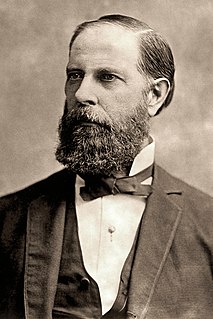
William Hayden English was an American politician. He served as a U.S. Representative from Indiana and was the Democratic Party nominee for vice president in 1880.
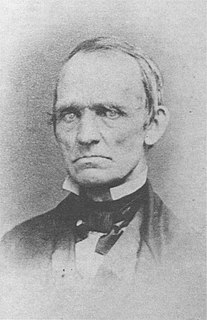
Samuel Merrill, a native of Peacham, Vermont, was an early lawyer and leading citizen of Indiana, who served as state treasurer from 1822 to 1834. Merrill attended Dartmouth College, and in 1816 settled in Vevay, Indiana, where he established a law practice and served in the Indiana General Assembly as a representative from Switzerland County (1821–22). Merrill resigned his position as state treasurer in 1834 to become the president of the State Bank of Indiana (1834–44); he also served as the president of the Madison and Indianapolis Railroad Company (1844–48) and head of the Merrill Publishing Company, which later became the Bobbs-Merrill Company. In addition to his government service and business ventures, Merrill was the second president of the Indiana Historical Society (1835–48), a founder and trustee of Wabash College, and an elder in the Second Presbyterian and Fourth Presbyterian churches in Indianapolis.
Stephen Selwyn Harding was an American politician, lawyer, anti-slavery leader and ardent abolitionist in Indiana who served as governor of the Utah Territory (1862–1863) and as chief justice of the Colorado Supreme Court (1863–1865). Because Harding proved to be unpopular with the territory's Mormon leaders and citizens, he remained at Salt Lake City for less than a year before President Abraham Lincoln appointed him to the judgeship at Denver. In 1865 Harding returned to Indiana, where he practiced law until his retirement in 1881. Earlier in his political career, Harding helped organize the Liberty Party in Indiana and was the party's candidate for lieutenant governor of Indiana in 1843 and 1846, but lost both races. Harding subsequently became a member of the Free Soil Party in 1848 and was an early member of the Republican Party in Indiana in the 1850s.

Indiana Avenue is a historic area in downtown and is one of seven designated cultural districts in Indianapolis, Indiana. Indiana Avenue was, during its glory days, an African American cultural center of the area. The Indiana Avenue Historic District within the area was designated a United States national historic district in 1987.

George Washington Julian was a politician, lawyer, and writer from Indiana who served in the United States House of Representatives during the 19th century. A leading opponent of slavery, Julian was the Free Soil Party's candidate for vice president in the 1852 election and was a prominent Radical Republican during the American Civil War and the Reconstruction era.

Benjamin Harrison was an American politician and lawyer who served as the 23rd president of the United States from 1889 to 1893. He was a grandson of the ninth president, William Henry Harrison, creating the only grandfather–grandson duo to have held the office. He was also a great-grandson of Benjamin Harrison V, a founding father who signed the United States Declaration of Independence.
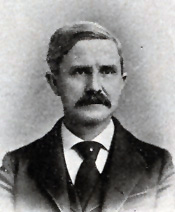
Charles Lewis Henry was a U.S. Representative from Indiana.

William Dale Owen was a U.S. Representative from Indiana. Before serving in Congress he was a clergyman, attorney, newspaper editor, and the author of two books. After serving in Congress and as Secretary of State of Indiana, he engaged in various business ventures, including promotion of coffee and rubber plantations in Mexico. In 1905 his business partner was arrested; in 1906 the partner was convicted of fraud and theft, and imprisoned. Owen left the United States to avoid prosecution; what happened to him after he fled the country is not known.

William Ellis Niblack was a U.S. Representative from Indiana

Jacob Piatt Dunn Jr. was an American historian, journalist, and author. A political writer and reformer, Dunn worked on ballot reform issues based on the Australian ballot system, authored a new Indianapolis city charter, and served as adviser to Indiana governor Thomas R. Marshall and U.S. Senator Samuel M. Ralston.

May Wright Sewall was an American reformer, who was known for her service to the causes of education, women's rights, and world peace. She was born in Greenfield, Milwaukee County, Wisconsin. Sewall served as chairman of the National Woman Suffrage Association's executive committee from 1882 to 1890, and was the organization's first recording secretary. She also served as president of the National Council of Women of the United States from 1897 to 1899, and president of the International Council of Women from 1899 to 1904. In addition, she helped organize the General Federation of Women's Clubs, and served as its first vice-president. Sewall was also an organizer of the World's Congress of Representative Women, which was held in conjunction with the World's Columbian Exposition in Chicago in 1893. U.S. President William McKinley appointed her as a U.S. representative of women to the Exposition Universelle (1900) in Paris.
Samuel Dunn Maxwell was an attorney and the eighth mayor of the city of Indianapolis, Indiana. Under his administration, Indianapolis Fire Department became a professional force.

Charles Elbridge Cox was an American lawyer and judge who became the 55th justice of the Indiana Supreme Court, serving from 1911 to 1917. Elected as a Democrat in the Fall of 1910, he was Chief Justice by the end of his six-year term. The "Marshall Constitution" case and the "Technical Institute" case were among the important decisions made by the court during his tenure. As a judge in the Indiana Supreme Court and in lower courts, he never had a decision reversed.
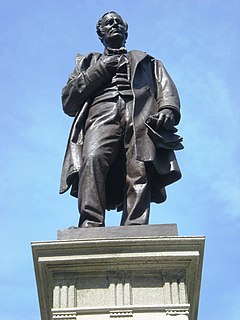
The Thomas A. Hendricks Monument is a public artwork by American artist Richard Henry Park and is located on the southeast corner of the Indiana Statehouse grounds in Indianapolis, Indiana. The monument is a tribute to Thomas A. Hendricks, the 21st Vice President of the United States. Hendricks was a former U.S. Representative and U.S. Senator from Indiana. He was the 16th Governor of Indiana and led the campaign to build the Indiana Statehouse.
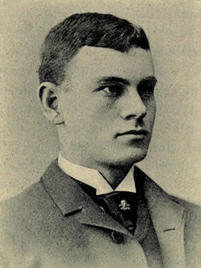
Clinton Larue Hare was a manager, organizer, and coach of American football, and a lawyer and grocer. He served as the head football coach at Butler University for three seasons, at Purdue University for one season in 1890, and at DePauw University for one season in 1891, compiling a career college football coaching record of 13–5–1.
John W. Cravens was the Registrar of Indiana University from 1895 to 1936.

Richard Dale Owen was a Scottish-born geologist, natural scientist, educator, and American military officer who arrived in the United States in 1828 and settled at New Harmony, Indiana. Owen, who was trained as a natural scientist and physician, served as an infantry officer in the U.S. Army during the Mexican–American War and the American Civil War. After the Civil War, Owen taught at Indiana University for fifteen years (1864–79) and chaired its natural science department. While retaining his faculty position at IU, Owen also served as Purdue University's first president (1872–74). During the interwar years, Owen taught natural science at the Western Military Institute in Kentucky and after its merger with the University of Nashville in Tennessee. In addition, Owen assisted his brother, David Dale Owen, with early geological studies of the Northwest Territory. In 1860 Richard Owen succeeded his brother to become Indiana's second state geologist. His research interests included geology, meteorology, terrestrial magnetism, and seismology. Owen authored scientific works that included geological surveys of several U.S. states.

Lawrence Van Buskirk was mayor of Bloomington, Indiana for eight years in the late 19th century. He was also postmaster and a bank president.
References
- 1 2 3 4 Theophilus A. Wylie; Indiana University (1890). Indiana University : its history from 1820, when founded, to 1890. Indianapolis: Wm. B. Burford. pp. 299–300. Retrieved May 26, 2018.
- 1 2 3 4 5 6 7 8 9 William Cumback; Jacob Beckwith Maynard (1899). Men of Progress, Indiana: A Selected List of Biographical Sketches and Portraits of the Leaders in Business, Professional and Official Life, Together with Brief Notes of the History and Character of Indiana. Indianapolis Sentinel Company. pp. 277–278.
- ↑ Indiana University (1892). The Indiana University Catalogue Register Announcements. p. 124.
- ↑ "Morey Dunlap is Dead". The Alexandria Times-Tribune. January 12, 1911. p. 3. Retrieved May 26, 2018– via Newspapers.com.